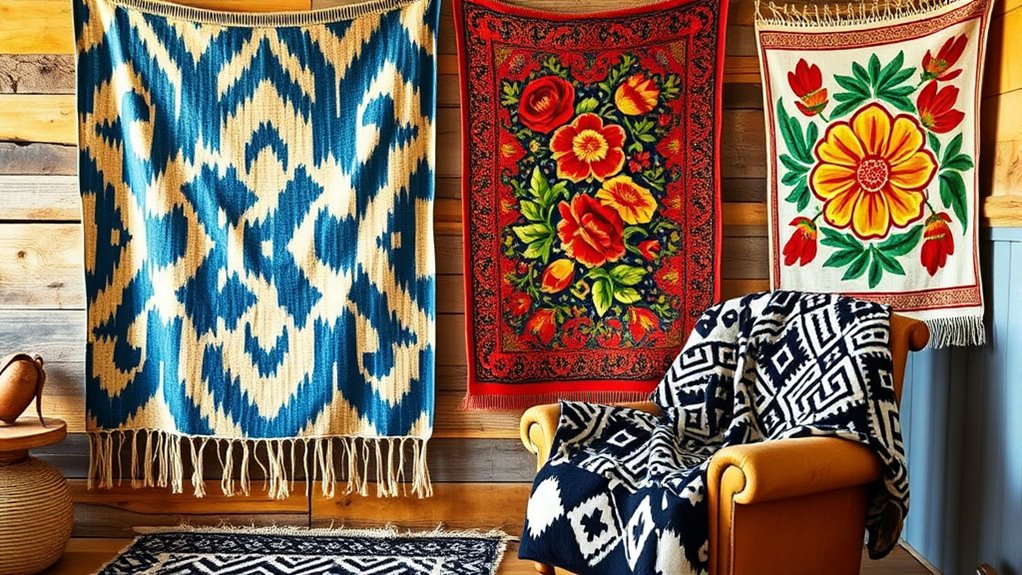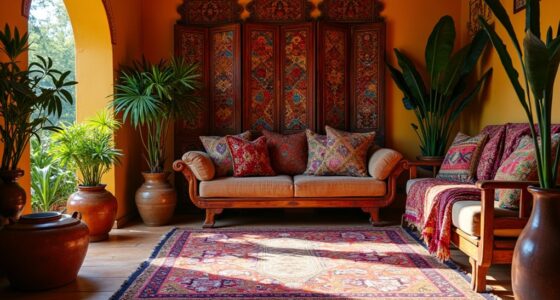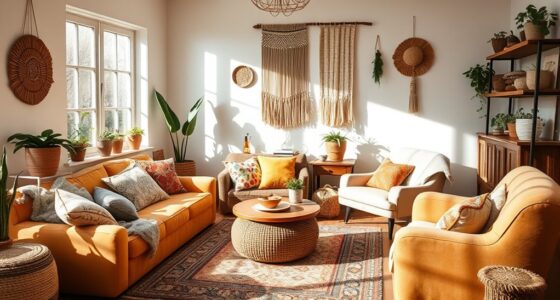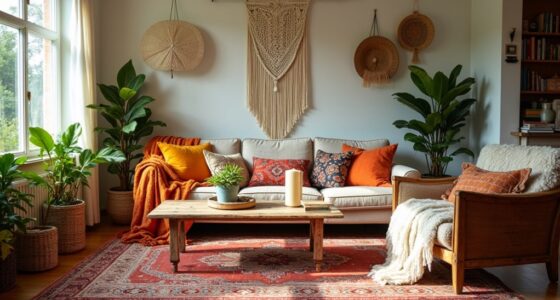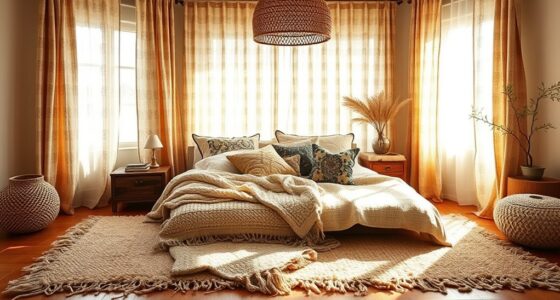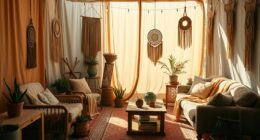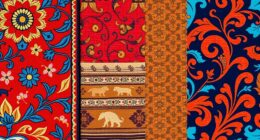In boho spaces, textiles like ikat, suzani, and mudcloth bring authentic, handcrafted character. Ikat features blurred, vibrant patterns created through resist-dyeing, while suzani’s bold embroidery and natural dyes tell cultural stories. Mudcloth adds earthy tones and geometric motifs with its resist-dyeing technique. These textiles provide a rich, global vibe and a handmade feel that instantly warms up your space. Keep exploring to discover how each piece can uniquely enhance your boho decor.
Key Takeaways
- Ikat textiles feature blurred, intricate patterns created through resist-dyeing, originating from Asia and South America, perfect for adding vibrant boho charm.
- Suzani textiles from Central Asia showcase bold embroidery and natural dyes, bringing cultural storytelling and rustic elegance to boho decor.
- Mudcloth from West Africa is known for earthy tones, geometric patterns, and resist-dyeing techniques, offering a rugged, artisanal feel for boho spaces.
- Authenticity in these textiles is marked by handcrafted details, traditional dyeing methods, and natural fibers like cotton, silk, or wool.
- Incorporating ikat, suzani, and mudcloth enhances boho interiors with global character, rich textures, and a mix of vibrant, earthy, and natural aesthetics.
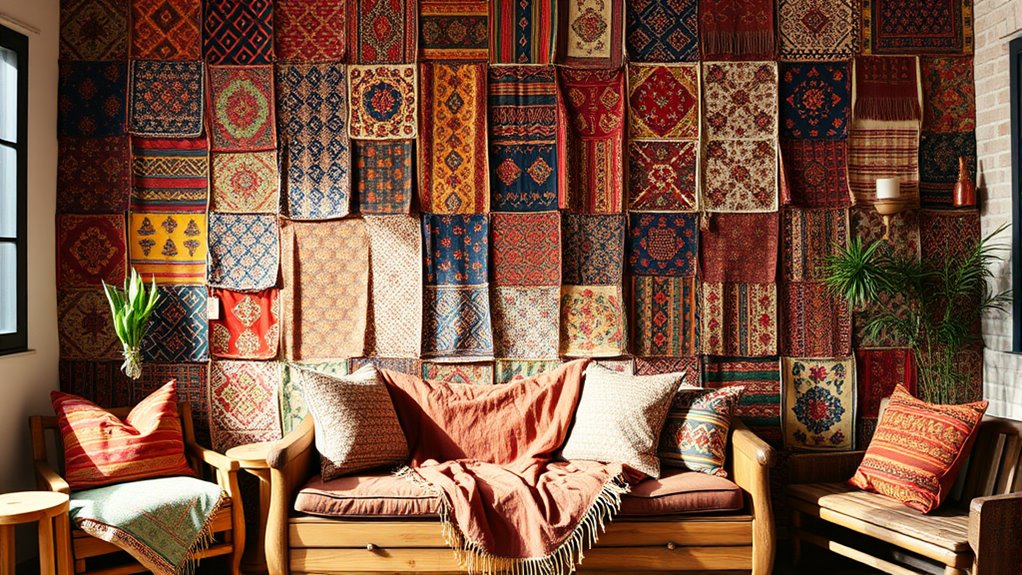
If you want to create a cozy, eclectic vibe in your space, choosing the right textiles is vital. The textiles you select can instantly add personality and depth, especially when you understand their origins and craftsmanship. For example, ikat, suzani, and mudcloth each have unique histories rooted in different cultures, and knowing their fiber origins and dyeing techniques helps you appreciate their beauty and significance. Ikat textiles, originating from regions like Central Asia, Southeast Asia, and South America, are renowned for their intricate, blurred patterns created through a specific dyeing process. In ikat, the yarns are carefully bundled and resist-dyed before weaving, which requires meticulous planning and skill. This resist-dyeing technique, often involving wax or latex, transforms the fibers into vibrant, complex designs that showcase the weaver’s craftsmanship. When choosing ikat for your space, pay attention to the fiber origins—cotton, silk, or wool—since each material lends a different texture and drape. Cotton ikat offers a casual, breathable feel, perfect for throws or cushion covers, while silk ikat adds a luxurious sheen suitable for statement pieces. The dyeing techniques used in ikat involve both traditional hand-dyeing and modern methods, but authentic ikat retains that characteristic blurred edge, a sign of its artisanal roots. Additionally, the authenticity of craftsmanship in ikat makes it a valuable and meaningful addition to any boho decor. Suzani textiles hail from Central Asia, particularly Uzbekistan, and are distinguished by their bold, embroidered designs. The fiber origins often include cotton or silk, which influence the textile’s durability and sheen. The dyeing techniques used for suzani involve natural dyes derived from plants, insects, and minerals, giving the fabric a rich, earthy palette. These dyes are applied through traditional methods like vat dyeing or hand-painting, which results in vibrant, long-lasting colors that deepen over time. Suzani’s embroidery is more than decoration; it’s a storytelling art form, with motifs inspired by nature, spirituality, and cultural symbolism. When integrating suzani into your boho space, consider how the natural dyes and fiber origins contribute to its rustic, handmade feel. The craftsmanship involved in both dyeing and embroidery ensures that each piece is unique, adding an authentic, global touch to your decor. Mudcloth, originating from West Africa, is another compelling textile choice. Made from cotton, its characteristic look comes from a resist-dyeing process called “batik” or “tie-dye,” using natural dyes like mud, indigo, or plant extracts. The fiber origins are fundamental because they determine the cloth’s texture and how the dye penetrates the fibers. Traditional dyeing techniques involve applying wax or tying sections of fabric to create patterns that resist the dye, resulting in striking geometric motifs. The use of natural dyes, especially mud, produces earthy tones that perfectly complement a boho aesthetic. Over time, the fabric’s surface develops a patina, adding to its charm and authenticity. Mudcloth’s rugged, handmade appeal makes it an ideal textile for pillows, wall hangings, or upholstery, infusing your space with a sense of history and craftsmanship rooted in West African traditions. Understanding the fiber origins and dyeing techniques of these textiles helps you select pieces that not only look great but also carry meaningful stories and artisanal value.
Frequently Asked Questions
How Do I Care for and Clean These Delicate Textiles?
To care for and clean these delicate textiles, follow essential textile preservation and cleaning tips. Gently vacuum with a soft brush attachment to remove dust, and spot clean with a damp cloth and mild soap when needed. Avoid harsh chemicals and direct sunlight to prevent fading. Hand wash or dry clean if necessary, and store textiles in a cool, dry place. Regular maintenance keeps your boho textiles vibrant and beautiful.
Can I Mix Different Textile Styles Without Clashing?
Think of your space as a vibrant tapestry—mixing different textile styles can create stunning design harmony if you choose wisely. Yes, you can mix textiles like Ikat, Suzani, and Mudcloth, but focus on balancing colors and patterns to avoid clashing. By blending contrasting textures and coordinating color palettes, you’ll craft a cohesive, eclectic look that highlights each textile’s unique charm without overwhelming your space.
What Are the Best Ways to Incorporate Textiles Into Small Spaces?
You can make small spaces feel cozy by focusing on textile layering and color coordination. Start with a neutral base, then add patterned textiles like Ikat or Suzani for depth. Mix textures to create visual interest, but keep color schemes harmonious to avoid clashing. Use throws, pillows, and rugs thoughtfully, ensuring each piece complements the others. This approach maximizes style without overwhelming your space.
Are These Textiles Suitable for Outdoor Use?
These textiles can be suitable for outdoor use if they have good weather resistance and durability. Look for options made with synthetic fibers or treated fabrics that withstand moisture, sun, and fading. Regularly clean and store them properly during harsh weather to prolong their lifespan. While traditional Ikat, Suzani, and Mudcloth textiles are often delicate, choosing outdoor-specific versions guarantees they stay vibrant and last longer outside.
How Do I Identify Authentic Handmade Textiles From Replicas?
To identify authentic handmade textiles, focus on textile sourcing and authenticity markers. Look for irregularities in weave and color, which indicate handcrafting rather than machine production. Check for natural dyes, slight imperfections, and unique patterns that reflect traditional techniques. Research the origin and supplier, ensuring they provide transparent information about their sourcing. These authenticity markers help you distinguish genuine handmade textiles from replicas, ensuring you get quality, culturally rich pieces.
Conclusion
Now that you know the basics of ikat, suzani, and mudcloth, it’s clear these textiles can transform your space into a vibrant boho oasis. With their rich history and striking patterns, they bring warmth and personality that no mass-produced decor can match. Immerse yourself in the world of global textiles and let your space become a mesmerizing tapestry of culture and creativity—your home will feel more alive than ever, like a colorful symphony in full swing!
